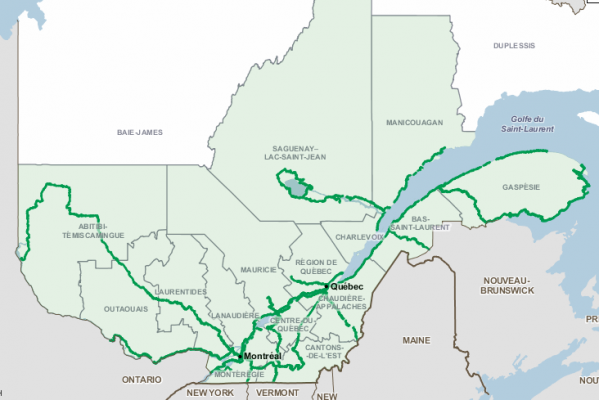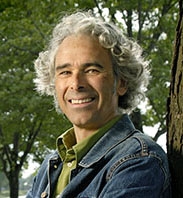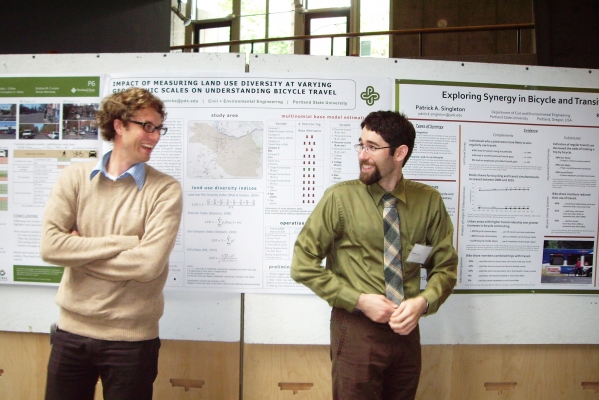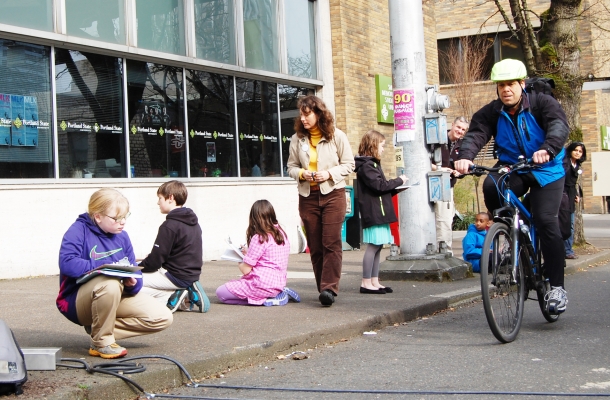(First published by BikePortland.org)
Portland has a network of neighborhood greenways, and they're great. But Jean-Francois Pronovost's is 3,100 miles long. That's approximately the distance from Portland to Nicaragua.
The Greenway (Route Verte in Pronovost's native French) is a bike route network running all over the Canadian province of Quebec. On Monday, the vice president for development and public affairs at advocacy group Vélo Québec visits Portland to share lessons from this project and others in the first annual Ann Niles Transportation Lecture, a major new series produced by Portland State University's Institute for Bicycle and Pedestrian Innovation.
The event is free, though space is limited to 240. On Thursday, BikePortland spoke with Pronovost to learn more about his life's work, the best parts of Quebec bike touring and how his hometown of Montreal managed to replace 320 auto parking spaces with a downtown protected lane that carries 9,000 bikes per day. Questions and answers were edited for space.
Can you describe your most famous achievement, the Route Verte??
The Route Verte [pronounced with hard Ts...
Read moreIBPI, or the Initiative for Bicycle and Pedestrian Innovation, is a center for research and learning that is focused on bicycle and pedestrian travel.
Based at Portland State University, the group's aim is to advance bicycling and walking as integral elements of the transportation system in Oregon’s communities. July 24 -26 IBPI hosted a faculty workshop to help transportation professors integrate bicycle and pedestrian topics into their courses.
Aimed at faculty members teaching transportation courses within an accredited planning or engineering program at the university level, the workshop included curriculum, guidebooks, and field trips to gain first-hand knowledge of bicycle and pedestrian facilities in Portland, Oregon.
It was kept small, to allow for discussion and interaction. The workshop's 15 participants were first given the chance to describe the existing gaps in their courses and what they hoped to gain from the workshop, then guided through a two-day series of activities tailor-made to fit their needs.
Their goals ranged from specific to general, requesting ways to incorporate GIS analysis into bicycle and pedestrian courses, suggestions for how to integrate active travel performance measures with typical vehicular performance measures, and generally a deeper understanding of bicycle research.
Robert Bertini (Portland...
Read moreThe Ann Niles Transportation Lecture series opens Aug. 26 with a lecture from Jean-François Pronovost of Vélo Québec titled "Growing a World-Class Cycling Culture: Lessons from Québec." The series is sponsored by the Ann Niles Transportation Lecture Endowment and serves as a legacy to Ann Niles, an advocate for livable neighborhoods.
Philip Niles created the endowment with a gift to the Initiative for Bicycle and Pedestrian Innovation, or IBPI, in honor of his late wife. Ann Niles was a strong advocate for livable neighborhoods and served on many transportation-related boards and committees in Portland.
The lecture series keeps alive the spirit of Ann Niles' advocacy. Niles pushed for better sidewalks and crosswalks to make Portland a safe and comfortable place to walk, and for bicycle routes and parking to do the same for bicycling.
"This inaugural Ann Niles Transportation Lecture, and all those that follow, help spread Ann's passion for creating livable neighborhoods to students, practitioners and the greater community," said OTREC Director Jennifer Dill.
The series' first speaker, Pronovost, has helped bring active transportation into the lives of people in communities across Québec. As vice president for development and public affairs for Vélo Québec, he helps develop new projects and partnerships.
One of the...
Read morePortland, Oregon is known for being a bike city, even called America's Best Bike City by Bicycling Magazine, so it's no surprise at all that Portland State University is full of bike enthusiasts.
Calvin Tribby, a Ph.D. candidate at the University of Utah, was recently awarded one of NITC's 2013 dissertation fellowships.
Five OTREC-supported student transportation researchers presented their work Wednesday at Portland State University's first Student Reserach Symposium. Tara Goddard and Katherine Bell presented their work in panel sessions, while Sam Thompson, Patrick Singleton and Oliver Smith presented posters.
Goddard presented her paper, "Are Bicycling and Walking 'Cool'?: Adolescent Attitutes About Active Travel," in the public health and urban studies session. She'll offer an in-depth take on the same topic at noon May 24 for OTREC's Friday transportation seminar. Click here for more information.
Bell's paper, "Evaluation of Smart Phone Weight-Mile Truck Data for Supporting Freight Modeling, Performance Measures and Planning," details some of her work with civil engineering associate professor Miguel Figliozzi. Click here to download a version of the paper.
Thompson's poster was "A Study of Bicycle-Signal Compliance Employing Video Footage;" Singleton's poster was "A Theory of Travel Decision-Making: Applications for Active Travel;" Smith's was "The Effects of Mode Choice on Subjective Well-Being: Evidence from Portland, Oregon."
The...
Read moreOTREC turned its education efforts on a decidedly younger crowd March 13: sixth graders. A class from Rochester, N.Y., visited Portland on a trip geared toward improving bicycling in their own community.
The students, from Genesee Community Charter School, visited the OTREC offices to learn about active transportation research methods. They took part in group exercises designed to get them thinking about the planning and engineering challenges of transportation systems set up to serve multiple transportation modes.
The highlight of the day came when the students took to Portland’s streets — OTREC’s living laboratory — to conduct research of their own. Armed with bicycle-counter tubes and infrared detectors, students counted cyclists and pedestrians passing on the Broadway cycle track on Portland State University’s campus.
Other students verified the technology with manual counters.
Students moved on to their next stop on a four-day tour of Portland with a better sense of what kind of data researchers collect and how they can use those data to inform policy. Given their experience — the students already have influenced their city on policy ranging from Erie Canal re-watering to an urban art corridor to skate parks — they stand a good chance of using Portland’s lessons to build a bike-friendly Rochester.
Tessa Walker, a Portland State University master's student in urban planning, has launched a national survey on skateboarding for transportation for her thesis resesarch. Walker sees skateboarding as a mostly unexplored corner of active transportation, with little information available to guide urban planners.
The study is open to people 18 and older in the U.S. and Canada who have skated as a way to get around within the last five years. Responses will be kept confidential and used for research purposes only.
To take the study or learn more, visit:
http://skatestudypdx.wordpress.com/
National Geographic recently described Portland as the City that “…gets almost everything right; it’s friendly, sustainable, accessible, and maybe a model for America’s future” (Cover story, Dec. 2009). Portland has a shared vision of a livable city, articulated in many different ways. It is seen in neighborhood self-help projects, big municipal investments, enlightened developers that build infill projects consistent with city plans, and the highest recycling participation rate in the country. Taken together Portland is a city that is environmentally responsible, and conscious of both street level and of global impact of doing things right.
Early History
Arguably, Portland’s first act of ‘building green’ was in 1892, when it built a reservoir network to protect and preserve the sole source of its drinking water, the pristine . Today, this 102-square mile conservation zone provides ample fresh water to a region of half million people
Fast forward almost 100 years and the same ethic motivated Portlanders to reject a Robert Moses-style highway plan...
Read more





